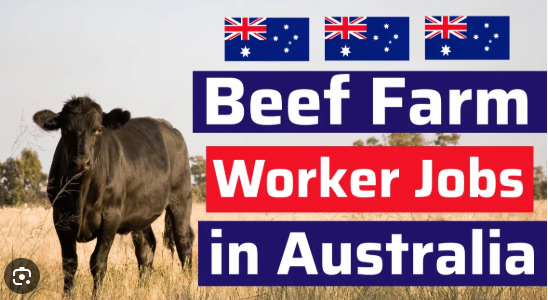Beef Farm Worker Jobs in Australia with Sponsorship 2025 Australia’s beef industry is a major economic driver, and due to ongoing labor shortages in rural areas, many farms are actively seeking international workers with visa sponsorship options in 2025. Roles typically involve hands-on livestock care, farm maintenance, and operations on cattle stations or beef farms. These positions are often full-time and located in regional or remote areas, offering competitive salaries, accommodation, and pathways to longer-term stays or permanent residency in some cases
Overview of Beef Farm Worker Jobs in Australia with Sponsorship in 2025
Sponsorship is commonly available through employer-nominated visas, especially for skilled or semi-skilled workers. Opportunities are particularly high during peak seasons like calving and breeding (typically spring and summer). Based on current listings, there are hundreds of farm-related jobs with sponsorship filters across platforms like SEEK, Indeed, and Jora, though beef-specific roles may overlap with general livestock or cattle positions.
Job Description
Beef farm workers handle daily operations on cattle farms, focusing on animal welfare, herd management, and farm upkeep. Common responsibilities include:
- Feeding, watering, and herding cattle.
- Monitoring livestock health, assisting with vaccinations, and reporting issues.
- Maintaining fences, equipment, and facilities.
- Operating machinery like tractors or trucks for tasks such as pasture management.
- Supporting breeding, calving, and mustering activities.
- Adhering to biosecurity, safety, and environmental standards
Requirements
Employers prioritize practical skills over formal qualifications, but the following are typically expected:
- Physical Fitness: Ability to perform demanding outdoor work, including heavy lifting and long hours in varying weather.
- Experience: Basic knowledge of livestock handling is advantageous; prior farm, animal care, or machinery operation experience boosts chances. Entry-level roles offer on-the-job training.
- Skills: Reliability, teamwork, and adaptability to rural life. A driver’s license and experience with working dogs may be required for some cattle roles.
- Age and Eligibility: Most visas require applicants to be 18–45 years old (depending on the visa type). English proficiency (e.g., IELTS score of 5.0+) is often needed for sponsored visas
Salary and Benefits
Salaries for beef farm workers in 2025 vary by experience, location, and role but are generally above the national minimum wage for agriculture ($32.31 per hour as of mid-2025).
- Entry-Level: AUD 55,000 per year.
- Experienced/Specialized: AUD 65,000–90,000 per year, plus superannuation (retirement contributions, around 11.5% of salary).
- Hourly Rates: Often 30–30–35 per hour for casual or seasonal work, with overtime pay during busy periods.
Additional perks commonly include:
- Free or subsidized accommodation and meals on remote farms.
- Transport, health insurance, and paid leave.
- Seasonal bonuses or utilities allowances.
- Opportunities for skill development, which can lead to higher-paying roles or visa extensions.
For example, station hand roles in cattle work can offer 80,000–80,000–90,000 annually, while dairy-adjacent livtock positions (which sometimes overlap with beef) range from 70,000–70,000–76,000 plus housing.
Locations
Beef farming is concentrated in regional and rural Australia, where labor shortages are acute. Key states for sponsored jobs include:
Queensland: Largest beef-producing state; roles on large cattle stations in areas like the Outback or Darling Downs.
New South Wales: Central West and Riverina regions; opportunities in mixed livestock farms.
Western Australia: Kimberley and Pilbara areas; remote stations with high demand.
Victoria and Tasmania: More dairy-focused but with some beef crossover in Gippsland or near Smithton.
South Australia: Near Mt. Gambier for livestock operations.
Visa Sponsorship Options
Sponsorship is employer-driven, so securing a job offer is the first step. Common visas for beef farm workers in 2025 include:
- Temporary Skill Shortage (TSS) Visa (Subclass 482): For skilled workers; valid 2–4 years, with potential for permanent residency. Farms in short-supply areas (e.g., regional) can sponsor under this.
- Working Holiday Visa (Subclass 417 or 462): For ages 18–30/35; allows farm work to extend for a second or third year (88 days of specified work required). Ideal for entry-level roles.
- Skilled Employer Sponsored Regional (Provisional) Visa (Subclass 494): For regional farms; 5-year visa leading to PR after 3 years. Requires a Designated Area Migration Agreement (DAMA) in some regions.
- Agriculture Visa (Proposed/Expanding in 2025): Targets seasonal workers; requires a job offer, health checks, and no more than 4 years total stay. Nationality eligibility applies (e.g., Pacific Island countries prioritized, but open to others).
Current Job Examples (as of October 2025)
From recent listings (note: availability changes; verify on sites):
- Station Hand (Cattle Work): McAg Farms, Queensland – 80,000–80,000–90,000/year; full-time; modern machinery and growth opportunities. (No explicit sponsorship mentioned, but under farm sponsorship searches.)
- Experienced Stockman: Forbes, NSW – Excellent pay + housing/vehicle; immediate start; requires working dogs.
- Farm Hand (Livestock Operations Lead): Witheren, QLD – 70,000–70,000–75,000 + super/house; day-to-day cattle management.
- Senior Farm Hand (Dairy/Livestock, potential beef overlap): Aurora Dairies, various VIC/TAS/SA locations – 70,000–70,000–76,000 + super/accommodation; experienced workers preferred.
How To Apply
Apply Now
Conclusion
In summary, beef farm worker jobs in Australia with visa sponsorship remain a promising opportunity in 2025, driven by persistent labor shortages in the agricultural sector, particularly in regional and remote areas like Queensland, New South Wales, and Western Australia. With hundreds of farm-related positions available across platforms like SEEK (301 full-time sponsorship farm jobs) and Indeed (437 visa sponsorship farm and cattle jobs), international workers can access entry-level to experienced roles offering salaries from AUD 55,000 to 90,000 annually, plus benefits like accommodation and superannuation.
Frequently Asked Questions (FAQs)
Here are some common questions about beef farm worker jobs in Australia with sponsorship in 2025, based on current trends and visa information. These are compiled from reliable sources on agriculture visas and job opportunities.
- What visas are available for beef farm workers with sponsorship in 2025?
Common options include the Temporary Skill Shortage (TSS) Visa (Subclass 482) for skilled temporary work (2–4 years), the Working Holiday Visa (Subclass 417 or 462) for younger travelers (18–35, extendable via 88 days of farm work), the Skilled Employer Sponsored Regional (Provisional) Visa (Subclass 494) for regional roles leading to PR after 3 years, and the Agriculture Visa for seasonal agricultural labor (up to 4 years total stay, requiring a job offer from a registered employer).478 For managerial beef roles (e.g., Beef Cattle Farmer, ANZSCO 121312), skilled migration visas like Subclass 189 or 190 may apply with experience. Note: The Beef Cattle Farm Worker (ANZSCO 842311) pathways are still under review, so employer nomination is key.3 - What are the eligibility requirements for sponsorship as a beef farm worker?
You typically need to be 18–45 years old (depending on the visa), have basic English proficiency (e.g., IELTS 5.0+), no serious criminal record, and good health. Practical experience in livestock handling, physical fitness for outdoor work, and a valid driver’s license are advantageous. Employers must prove they can’t hire locally, and you’ll need a job offer. For the Agriculture Visa, proof of employment from an Australian agricultural business is required.45 No formal qualifications are always needed for entry-level roles, but skills assessments may apply for PR pathways. - How much can I earn as a beef farm worker with sponsorship in 2025?
Entry-level salaries start at around AUD 55,000 per year (or 30–30–35/hour for casual work), rising to AUD 65,000–90,000 for experienced roles, plus 11.5% superannuation. Additional benefits often include free accommodation, meals, transport, and overtime pay during peak seasons like calving. The national minimum for agriculture is $32.31/hour as of mid-2025.56 - Where are the best locations for beef farm jobs with sponsorship?
Queensland leads as the top beef-producing state, with opportunities on cattle stations in the Outback or Darling Downs. Other hotspots include New South Wales (e.g., Central West), Western Australia (Kimberley/Pilbara), and parts of Victoria/South Australia for mixed livestock. Regional areas qualify for more sponsorship options under visas like Subclass 494.59 Remote locations often offer higher pay and housing incentives.




